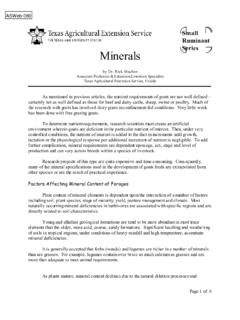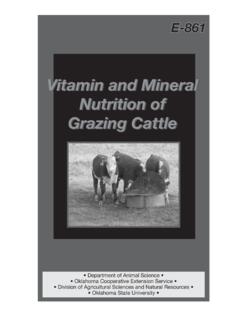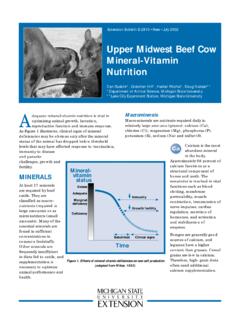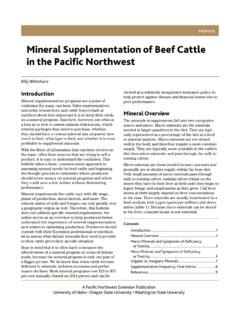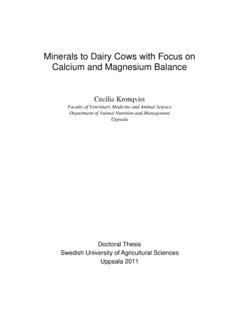Transcription of Chapter 6 Livestock Nutrition, Chapter 6 - NRCS
1 Chapter 66 i(190-vi, NRPH, September 1997) Livestock nutrition , Husbandry, andBehaviorNational Range and Pasture Handbook6 iChapter 6 Livestock Nutrition, Husbandry, and 1(a) Energy .. 6 metabolism6 3(a) Factors affecting basal metabolism and voluntary intake .. 6 a balance between Livestock numbers and available6 8forage(a) Determining animal-unit equivalents .. 6 8(b) Ability of cattle to adjust to fluctuating forage quality .. 6 9(c) Chemical factors affecting forage quality .. 6 10(d) Forage quantity .. 6 10(e) Nutrient needs of animals .. 6 14(a) Supplementing forage deficient in nutrients .. 6 14(b) Proper location of salt, minerals, and supplemental feed.
2 6 of Livestock parasites and diseases6 the breeding season6 17(a) Controlled breeding program .. 6 17(b) Advantages of controlled breeding .. 6 17(c) Factors in planning a breeding program .. 6 17(d) Reproduction characteristics .. 6 18(e) Additional factors in Livestock breeding and selection .. 6 behavior6 19(a) Systems of behavior .. 6 19 National Range and Pasture HandbookLivestock nutrition , Husbandry, andBehaviorChapter 66 ii(190-vi, NRPH, September 1997)TablesTable 6 1 Gross energy values of feeds6 2 Table 6 2 Energy adjustments for cattle6 3 Table 6 3 Description of body condition scores6 5 Table 6 4 Typical thermoneutral zones6 6 Table 6 5 Animal-unit equivalents guide6 9 Table 6 6 Biological priority for nutrients6 10 Table 6 7 Expected water consumption of various species6 12of adult Livestock in a temperate climateTable 6 8 Water quality standards for livestock6 12 Table 6 9 Approximate number of animals at one salting6 16location to provide enough salt and minerals ondifferent types of terrainTable 6 10 General salt requirements for grazing animals6 16 Table 6 11 Reproduction characteristics of domestic animals6
3 18 Table 6 12 Behavior of a cow on winter range6 19 FiguresFigure 6 1 Components of a food6 1 Figure 6 2 Energy functions6 2 Figure 6 3 Relationship between BCS and pregnancy percentage6 5 Figure 6 4 Reference points for body condition score6 5 Figure 6 5 Water requirements of European and Indian cattle6 12as affected by increasing temperaturesFigure 6 6 Fractions of a feedstuff6 146 iiChapter 66 iii(190-vi, NRPH, September 1997) Livestock nutrition , Husbandry, andBehaviorNational Range and Pasture HandbookExampleExample 6 1 Nutritional profile of a cow year6 13 ExhibitExhibit 6 1 Livestock and wildlife summary and data sheet6ex 16 iiiNational Range and Pasture HandbookLivestock nutrition , Husbandry, andBehaviorChapter 66 iv(190-vi, NRPH, September 1997) Chapter 66 1(190-vi, NRPH, September 1997)
4 Livestock nutrition , Husbandry, andBehaviorNational Range and Pasture HandbookChapter 6 Livestock nutrition , Husbandry, GeneralSuccessful conservation and efficient use of grazinglands depend on correlation of the treatments andmanagement of forage plants with the management ofthe animals that harvest the plants. NRCS conserva-tionists who work with Livestock producers must bethoroughly familiar with locally adapted livestockhusbandry and Livestock management principles andpractices applicable to obtain proper and efficient useof grazing resources. They should not provide techni-cal advice or assistance to Livestock producers onmatters relating primarily to animal breeding, genetics,or animal health problems (except when animal healthis related to forage resources).
5 Conservationistsshould acquire enough information about these mat-ters to enable themselves to adequately discuss live-stock health, nutrition , and behavior with greatest challenge associated with successfullivestock management and in integrating grazingmanagement and forage production is animal nutri-tion. Understanding the complex issues of animalnutritional demand, forage nutritional values, andgrazing management influence on forage nutritionalvalues and production is the key to successful plan-ning and management on grazing NutritionDeveloping a good feeding and management programis important for managers to meet Livestock goals andherd performance objectives. Many factors affect therequirements of animals and the extent of nutrientutilization.
6 The effect of genotype, physiological state,and environment on voluntary feed consumption ismediated by the animals metabolism, and consump-tion is generally dependent upon animals take in food of plant origin, the energycontained in those plants is used for maintaining bodyfunctions (respiration, blood flow, and nervous systemfunctions), for gain of tissue in growing animals, andfor products (milk, wool). The synthesis of protein inthe animal s body, which forms muscle, organs, softbody tissue, and animal products, should be the mainobjective of animal nutrition . Different kinds of ani-mals and various breeds have different nutritionalrequirements during the year and acquire differentvalues from forages and supplements.
7 See exhibit 6 1for kinds of animals (beef and dairy cattle, sheep,goats, and horses) and representative breed bulk of dry matter in plants is made up of threegroups of organic compounds: Proteins Carbohydrates FatsCarbohydrates, proteins, and fats (fig. 6 1) are thefuels that animal cells are capable of converting intovarious forms of energy. This energy is used for me-chanical work of muscles, synthesis of macromol-ecules from simpler molecules, and for providing energy is referred to as a calorie (cal).Figure 6 1 Components of a foodFoodWaterDry MatterInorganic matterOrganic matterCarbohydratesLipidsProtienNucleic acidsOrganic acidsVitaminsNational Range and Pasture HandbookLivestock nutrition , Husbandry, andBehaviorChapter 66 2(190-vi, NRPH, September 1997)(a) EnergyThe most important item in an animal s diet and over-all feeding standards is based on energy needs.
8 Meet-ing the energy requirements of an animal can be amajor cost in feeding. Animals derive energy frompartial or complete oxidation of carbohydrates, fats,and proteins ingested and absorbed from the diet orfrom breakdown of glycogen, fat, or protein absorbedin the body. Animals require some energy even in anonproductive state for sustaining the body and main-taining body temperature and muscular activity. Addi-tional energy is required when performing work andfor growth and fattening, pregnancy, and is partitioned into various functions in terms ofanimal utilization (fig. 6 2).Gross energy (GE) is the amount of heat resultingfrom the complete oxidation of a food. GE values fromfeedstuffs are used in the process of evaluating energyutilization.
9 Energy values and nutrients (carbohy-drates, proteins, and fats) values vary in GE values for some feeds are given in table 6 energy (DE) of a feedstuff is the con-sumed portion minus the fecal energy. Analyzing thefecal and feed energy allows for the calculation of energy lost in feces accounts for the single great-est loss of nutrients. Depending on species of animaland diet, fecal losses can be from 10 percent in milkfed animals to 60 percent for animals on poor 6 2 Energy functionsTable 6 1 Gross energy values of feedsFeedsGE, KCAL/GCorn oil oil energyHeat incrementTotal heat production of animal( ) not useful energy ( ) useful energyNet energyEnergy for productionEnergy for maintenanceMethane energyMetabolizable energyFecal energyDigestible energyUrine energyChapter 66 3(190-vi, NRPH, September 1997) Livestock nutrition , Husbandry, andBehaviorNational Range and Pasture HandbookMetabolizable energy (ME)
10 Is the gross energy offeed minus the energy in urine, feces, and gaseousproducts of digestion. The values of ME account foradditional losses in the digestion and metabolism ofingested feed. ME is used to establish feeding stan-dards because feces and urine are excreted generally accounts for the most combustiblegas in ruminant animals. In the fermentation processas much as 8 to 10 percent of the energy consumed isconverted to methane. Diets low in quality result inlarger proportions of methane, and the amount of GElost as methane decreases as feed intake energy (NE) is equal to metabolizable energyminus the heat increment and the heat of fermenta-tion. NE of a feed is the portion that is available to theanimal for maintenance or other productive accounts for most of the losses in metabolism of afeed or by the animal.











